
Rana hecksheri
Photo by RW Van Devender
Listed: State, Species of Special Concern
Description: This very rare species is North Carolina’s second largest frog, surpassed only by the bullfrog. The river frog closely resembles the bullfrog but is usually brown or olive with no bright green coloration. Its belly is predominantly gray or blackish, mottled with whitish. It has indistinct whitish spots as well as dark mottling on the upper and lower lips and usually a pale band around the groin. Its skin is usually slightly rougher than that of the bullfrog. Like the bullfrog, it does not have ridges running along its sides. Juveniles usually have a dark reddish iris, which turns brown or golden as the frog matures.
Habitats and Habits: River frogs are known from only a few historic localities along the Lumber and Cape Fear River systems in the southeastern Coastal Plain. River frogs are closely associated with blackwater river habitats, breeding in oxbow lakes, ponds, borrow pits, swamps or other permanent waters along such rivers. Eggs are deposited as a surface film. The river frog’s huge tadpoles are unmistakable and are more easily identified than the adult frogs. Rivaled in size only by those of the bullfrog, they may reach 6 inches in length and are easily identified by three dark stripes running the length of the tail. The tadpoles usually travel in large schools and take a year or more to transform.
Call: Neither eggs nor calling adults have been reported in North Carolina, but in other states, river frogs breed from April to August. Their call is a loud roar or snore, which has been compared to the sound of a distant chainsaw, a lawnmower or a train.
Frog Fact: River frogs apparently produce skin secretions that are toxic or distasteful to some predators. They are less wary and more easily captured than most other frogs and often go limp when handled. As of this writing, river frogs have not been reported from the state since 1975; they are thought to be extinct in North Carolina.
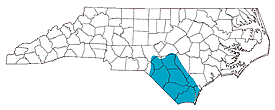
The shaded region represents the range of the river frog in North Carolina.

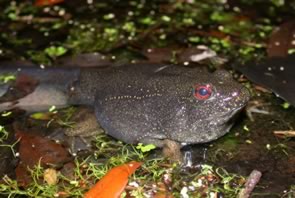
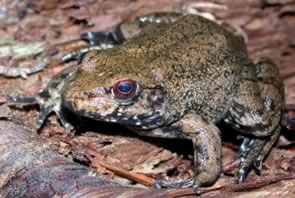
A river frog undergoing metamorphosis. Note the red eye.
Photo
by JD Willson
Photo by Steve Bennett
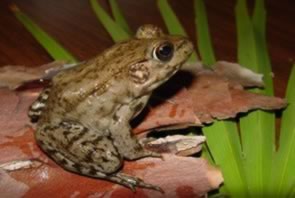
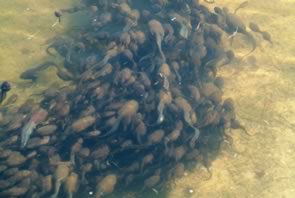
Photo by RT Zappalorti
This website created by: Grant Connette and Evan Eskew.
For comments or questions contact M. Dorcas: midorcas@davidson.edu.
M. Dorcas homepage: http://bio.davidson.edu/dorcas
Davidson College, Davidson, North Carolina 28035-1719.
Text and maps from: Dorcas, M. E., S. J. Price, J. C Beane, and S. S. Cross. 2007. The Frogs and Toads of North Carolina. North Carolina Wildlife Resources Commission, Raleigh, NC. – Copyright by Michael E. Dorcas
Call provided by Walter Knapp.
Partial Funding for this website provided by a Associate Colleges of the South, National Science Foundation, and Duke Energy.
